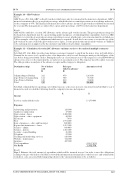Page 675 - SAIT Compendium 2016 Volume2
P. 675
IN 78 Income Tax acT: InTeRPReTaTIon noTes IN 78
Example 10 – Gift Vouchers
Facts:
ABC Stores (Pty) Ltd (ABC) sells gift vouchers which may only be redeemed in the homeware department. ABC’s nancial statements re ect a gross pro t percentage, which takes into account depreciation on store ttings and assets, for the company of 45%. The nancial statements also re ect advance income for gift vouchers sold but not redeemed by year-end. The management accounts re ect a gross pro t percentage of 40% for the homeware department.
Result:
ABC will be entitled to a section 24C allowance on the advance gift voucher income. The gross pro t percentage for the homeware department may be a good starting point for purposes of estimating future expenditure; however, ABC will have to review the gross pro t percentage calculation to assess whether any costs or income must be excluded (see 7.1 for examples of the type of adjustments which may be required). It will also be necessary to review the age of the gift vouchers because even if the gift vouchers never expire, at some point in time unredeemed vouchers are unlikely to be redeemed (for example, lost by the customer) and will not lead to future expenditure.
Example 11 – Calculation of section 24C allowance on future service to be rendered (multiple contracts)
Facts:
Safe Ride CC (Safe Ride) provides long distance passenger transport to and from the major cities in South Africa. Demand for its service is at a peak because of its impressive safety record. Passengers must pay the full price of the fare before being issued with a ticket. During the rst year of assessment (year 1) the taxpayer received R300 000 in advance for services to be rendered in the second year of assessment (year 2). The taxpayer has a December year-end. The table provides an analysis of the advance receipts and the taxpayer’s obligation:
Destination (trip)
No of tickets Price per
sold ticket in advance RR
Amount received
126 900 98 700 74 400
300 000
Johannesburg to Durban 282 Cape Town to Johannesburg 141 Cape Town to Durban 120 Total 543
450 700 620 300
Safe Ride estimated that its operating costs will not increase or decrease in year 2. An extract from Safe Ride’s year 1 nancial records revealed the following about the company’s income and expenses:
Income
Services rendered/ticket sales
Expenses
Advertising and promotion Auditor’s remuneration Depreciation – buses Depreciation – of ce equipment Electricity
Fuel
Rent of premises – of ce and bus depot Repairs and maintenance - buses Salaries – admin
Salaries – drivers
Security – rented building
Telephone
Tracking and monitoring services Website – maintenance
Insurance
Total expenditure
Net Pro t
Result:
RR
13 250 000
128 000 15 000 2 400 000 46 000 7 430 2 554 000 600 000 1 453 000 980 000 1 489 000 49 000 47 000 920 000 724 000 485 000
(11 897 430)
1 352 570
Step 1: Estimate the total amount of expenditure which will be incurred in year 2 in order to meet the obligations relating to the pre-sold tickets. Safe Ride reviewed the information in its nancial records for year 1 and estimated the total direct costs associated with transporting clients to the various destinations to be as follows:
saIT comPendIum oF Tax LegIsLaTIon VoLume 2 667


